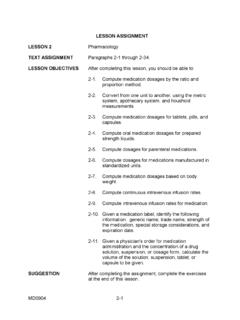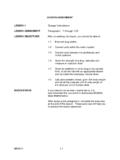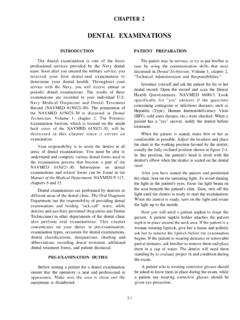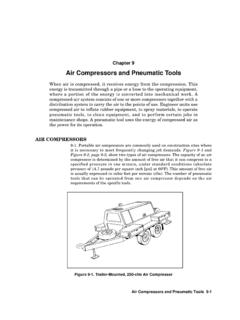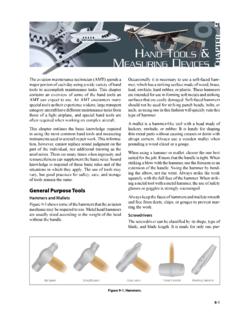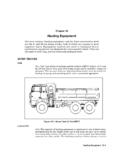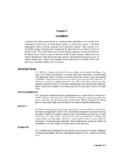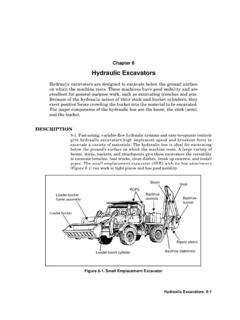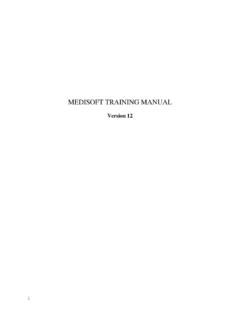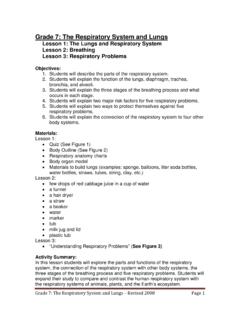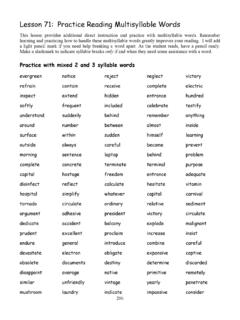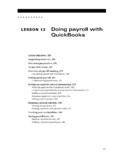Transcription of LESSON ASSIGNMENT LESSON OBJECTIVES
1 MD0501 4-1 LESSON ASSIGNMENT LESSON 4 Dental Anatomy. LESSON ASSIGNMENT Paragraphs 4-1 through 4-25. LESSON OBJECTIVES After completing this LESSON , you should be able to: 4-1. Identify the differences between groups of teeth. 4-2. Identify the number and characteristics of deciduous teeth. 4-3. Identify the permanent teeth according to the military numbering system. 4-4. Identify the terminology related to the surfaces of teeth.
2 4-5. Identify the division of teeth into thirds. 4-6. Identify basic anatomic terminology that describes the location, configuration, or shape of teeth. 4-7. Identify the correct description of the anatomy of each permanent maxillary tooth. 4-8. Identify the correct description of the anatomy of each permanent mandibular tooth. SUGGESTION After studying the ASSIGNMENT , complete the exercises at the end of this LESSON . These exercises will help you to achieve the LESSON OBJECTIVES . MD0501 4-2 LESSON 4 DENTAL ANATOMY Section I.
3 ASPECTS OF THE ANATOMIC DESCRIPTION OF TEETH 4-1. GENERAL Teeth are of different shapes and sizes. The primary function of teeth is to chew (masticate) food. They function in specialized ways in the preparation of food for digestion. There are two kinds of teeth--anterior and posterior. The anterior teeth are designed for the purpose of cutting and tearing food. The posterior teeth are designed for the purpose of grinding or crushing food. Teeth also have a role in speaking, by aiding in the production of sounds. Another function of teeth concerns appearance (esthetics). The presence or absence of teeth, their regularity or irregularity of position, and their color and condition greatly affect the appearance of the individual. The shape, size, number, and arrangement of teeth in a normal arch are such that they efficiently perform these major functions.
4 The character and general arrangement of teeth, taken as a whole, are referred to as the dentition. The individual has two sets of teeth during his lifetime. The first set is the primary (deciduous or temporary) set of 20 teeth. A later set is the secondary (permanent) set of 32 teeth. 4-2. ANATOMIC DIFFERENCES BETWEEN GROUPS OF TEETH The 32 teeth that are commonly found in the adult dentition have differences and similarities in form and function. For comparison, the teeth are often grouped as maxillary and mandibular teeth or as anterior and posterior teeth. a. Maxillary and Mandibular Teeth. The maxilla and the mandible contain the same number and types of teeth. There are certain distinct differences between the teeth of the two jaws. One of the differences is in the mesiodistal width between the maxillary and mandibular anterior teeth.
5 The normal relationship between the maxillary and mandibular teeth results in a horizontal and vertical overlap. The horizontal overlap is called overjet. The vertical overlap is called overbite. This results in a wider arch for the maxillary teeth to fill. It affects the anterior teeth because of the greater curvature of the anterior part of the dental arch. (There is little or no lateral curvature in the posterior part.) Other differences include the number of roots of molars (maxillary molars have three and mandibular molars have two), the configuration and the outline form of occlusal surfaces, and the nature of the curvature of vertical crown surfaces. MD0501 4-3 b. Anterior and Posterior Teeth. As indicated in paragraph 4-1, teeth may be divided into anterior and posterior groups.
6 Anterior teeth, commonly called "anteriors" when referred to as a group, include the central and lateral incisors and the cuspids. Posterior teeth, commonly called "posteriors" when referred to as a group, include the bicuspids and molars. Anterior teeth differ from posterior teeth in their relative position within the dental arch. They also differ in their form, their function, and their conformity to that part of the arch in which they are located. (1) Anterior teeth. Anterior teeth are characterized by having single roots and incisal edges or single-cusped crowns ending in narrow edges. These narrow edges are designed to incise (bite off) relatively large amounts of food in eating. Anterior teeth are located in the anterior part of the jaw. They are so aligned as to form a smooth curving arch from the distal of the cuspid of one side of the arch to the distal of the cuspid on the opposite side.
7 (2) Posterior teeth. Posterior teeth differ from anterior teeth in that they may have more than one root. They also differ in their form and function. They may also have multiple cusps forming occlusal surfaces designed to crush and grind food into small parts. (a) Bicuspids. Most bicuspids have single roots but may have roots which are partly or completely bifurcated (over one-half of all maxillary first bicuspids have such bifurcations). As their name implies, most bicuspids have two cusps. The mandibular second bicuspid may have either two or three cusps. The three-cusped bicuspid has two lingual cusps and one buccal cusp. (b) Molars. Molars are all multirooted (three roots in the maxillary arch and two roots in the mandibular arch). See figure 4-1. Molars have four or more cusps.
8 First permanent mandibular molars have five functional cusps. The maxillary first molars have four functional cusps and the cusp of Carabelli, a nonfunctional cusp located on the mesioloingual surface. Third molars are commonly called "wisdom teeth." They resemble second molars but are largely unpredictable as to form, size, and number of roots. Figure 4-1. Trifurcated and bifurcated roots. MD0501 4-4 4-3. DECIDUOUS TEETH The "deciduous dentition" is the common term used to designate the first set of teeth. a. Temporary Teeth or Primary Teeth. The terms "temporary teeth" or "primary teeth" are often used because these teeth are replaced by a permanent or second set early in life. The deciduous teeth are also called "baby" or "milk" teeth.
9 The first of the deciduous teeth push through the gums (erupt) at an average age of 6 months. All deciduous teeth are usually erupted by the end of the second year. b. Description of the 20 Deciduous Teeth. There are 20 deciduous teeth, 10 in each jaw. In each half of each jaw, beginning at the midline and extending backward, these teeth are called: central incisor, lateral incisor, cuspid, first molar, and second molar. See figure 4-2. The name for each tooth is made more specific by the addition of terms indicating its location within the mouth, such as maxillary (upper) left central incisor or mandibular (lower) right cuspid. Thus, there are four of each type of tooth. Each is individually designated as maxillary or mandibular and as right or left. c. Permanent Tooth Formation and Temporary Tooth Resorption.
10 During the period of deciduous dentition, the permanent teeth are in the process of formation within the jaw. In the course of development, the roots of the temporary teeth undergo resorption (gradually dissolve) until there is insufficient remaining root structure to support them. During the period from about 6 to 12 years of age, the temporary teeth thus loosen and are lost. Temporary teeth are replaced by permanent teeth in a physiologically controlled sequence. Figure 4-2. Deciduous teeth. MD0501 4-5 4-4. REPLACEMENT OF DECIDUOUS TEETH a. Replacement Teeth. The 10 deciduous teeth of each jaw are replaced by the 10 most anterior teeth of the permanent dentition (see figure 4-3) as follows: (1) The permanent central incisors replace the deciduous central incisors.
